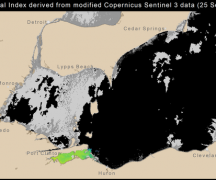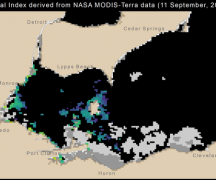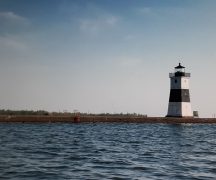From The National Centers for Coastal Ocean Science
The Western Lake Erie HAB Early Season Projection provides an estimate of potential Microcystis harmful algal bloom (HAB) severity. The projected severity depends on input of total bioavailable phosphorus (TBP) from the Maumee River during the loading season
(March 1-July 31), and uses a combination of measurements and forecasts of Maumee River discharge from the U.S. Geological Society and the National Weather Service — Ohio River Forecast Center (through July) and TBP loads measured by the Heidelberg University National Center for Water Quality Research.
With observations through May 6, we predict a potential bloom severity range of 2-4.5 (Mild to Moderate bloom conditions), similar to the 2023 (Mild) or 2022 and 2024 (Moderate) blooms.
Through the spring, conditions have been relatively dry except for a large precipitation and associated river discharge event in early April and another moderate precipitation event this week (early May). Near normal precipitation and river discharge are currently predicted for the remainder of the loading season (May-July).
The range in forecasted severity reflects the uncertainty in forecasting precipitation, particularly through June and July. We will issue a comprehensive seasonal forecast on June 26. Any bloom that does develop will change throughout the summer and move with the wind and currents. We will provide information on the presence and location of the bloom throughout the summer via monitoring and forecasts that are posted daily on the web, and emailed to subscribers weekly, in collaboration with NOAA’s Great Lakes Environmental Research Laboratory (GLERL).





